
Variety is not only the spice of life, it’s the benchmark of the Ontario greenhouse vegetable industry.
Variety is not only the spice of life, it’s the benchmark of the Ontario greenhouse vegetable industry.
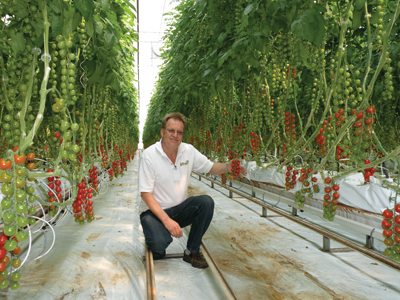
|
|
| Jack Pomp, head grower at Mastronardi Produce in Leamington | |
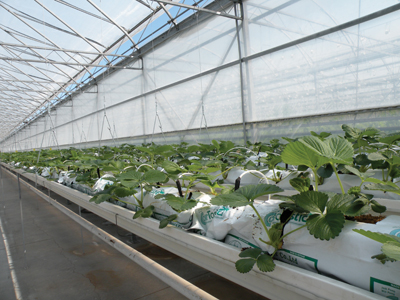
|
|
| Strawberry trials. | |
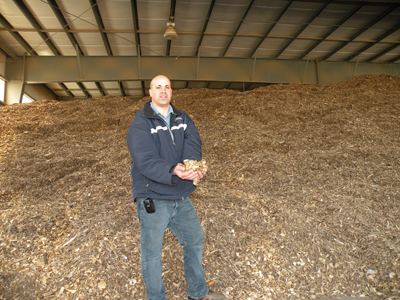
|
|
| In peak season, Agriville Farms burns 100 tons of wood chips a day, says manager Gianni Mucci. | |
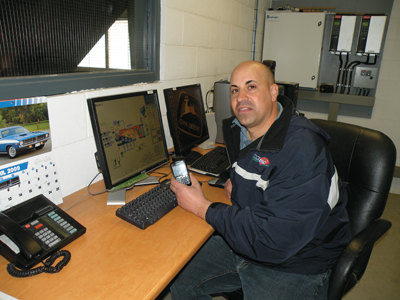
|
|
| Agriville Farms manager Gianni Mucci stays connected to the biomass system over his phone. | |
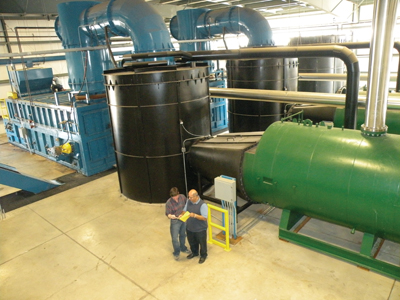
|
|
| Remasco’s Jim Gallant (at left) and OMAFRA’s Shalin Khosla in front of Southshore Farms’ new gasification system. | |
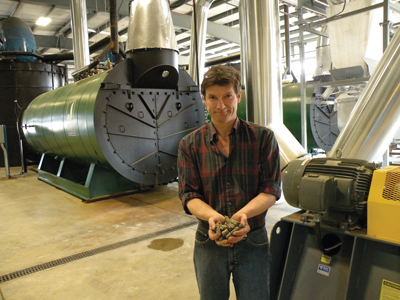
|
|
| Remasco engineer Jim Gallant, with a handful of the raw fuel. Advertisement
|
Years ago, the focus was primarily on beefsteak tomatoes and English cucumbers, with some pepper production.
Now, it’s a veritable cornucopia of varieties in the major crops, with growing production levels of cluster, cocktail, cherry, roma and grape tomatoes, mini-cucumbers and peppers in all colours and sizes.
According to Shalin Khosla, greenhouse vegetable specialist with the Ontario Ministry of Agriculture, Food and Rural Affairs, the province is home to 1,800 acres of greenhouse vegetable facilities. Much of it is located in the Leamington region, North America’s largest concentration of greenhouse vegetable production. The breakdown is 47 per cent in tomatoes, 29 per cent in peppers, and 24 per cent in cucumbers.
Specialty crops: Much of the expansion was in specialty crops, such as a larger range of cocktail tomatoes and coloured peppers, including browns and whites, along with sweet green varieties.
Peppers used to be the third largest crop in the province, but they’ve been making great headway in recent years. Of the 60 acres added last year, more than 70 per cent was in peppers.
More mini-cucumber production is underway, with about 30 acres in total. There is also some hot pepper production.
The province also has some eggplant production, with more growers becoming comfortable with it. It’s being grown in a variety of colours, shapes and sizes, says Khosla.
Just about all of the structures built last year were double poly.
Rockwool and coco are the two main substrates.
Nutrient recycling: There is also an increasing number of growers who are recycling their nutrient solution. All of the new construction included the installation of troughs to accommodate nutrient recycling. UV and ozone are the two main treatments to disinfect the nutrient solution, along with pre-filtration and post-filtration systems to help prevent blockage of irrigation line emitters. “Most growers are finding that when they are recycling, they’re seeing a minimum of 25 per cent savings on water and fertilizer use.”
The new greenhouses are also much taller, usually at least 18 feet tall and as high as 22 feet. “It results in much better growing conditions with better venting and environmental control,” Khosla explains.
Energy issues are front and centre with most growers, with heating accounting for between 35 and 40 per cent of production costs.
Increased conservation: Ontario growers are also incorporating more conservation measures. Energy curtains are effective, even in poly houses. They can result in savings of up to 25 per cent, if properly used. “With glass, you have to put energy curtains in. If you don’t,” says Khosla, “you’re just wasting energy.” Growers with double poly greenhouses are also installing them, and with good results.
Some growers installed a thin sheet of plastic above their crop, taking it off as the crop grew taller. “It added another insulation component,” notes Khosla, “and resulted in good energy savings.” It was used in both glass and double-poly houses, with savings in both structures. Growers have to modify their growing techniques to adjust for the extra layer of insulation.
Growers have been looking at all types of biomass fuels. “When the price of natural gas was quite high,” said Khosla, “there was a great push for alternative fuels.” With natural gas prices easing of late, “there’s not as much urgency.”
Wood chips is the current fuel of choice. Wood pellets would be easier to use, but they’re more expensive. “But if the price came down, you might find more growers using them.”
Other fuel sources being considered include such purpose-grown crops as miscanthus and switchgrass.
After many years of mostly double-poly construction, there has been some interest in glass the past few years. Glass means better light levels in the winter, while poly is usually better in moderating summer temperatures. “Both systems work well if you do a good job with them,” explains Khosla, “and with some of the new growing techniques, everyone is getting better at summer production. It’s a question of grower preference.”
We toured a couple of greenhouse to view some of the latest trends.
CONSTANTLY TRIALLING NEW VARIETIES
Totalling some 80 acres, Mastronardi Produce is one of the largest glass and plastic greenhouse operations in North America. It’s also a good example of a diversified growing operation, with a large number of tomatoes and peppers trialled each year.
Jack Pomp is the head grower and has been with the company since 1999. He and company vice-president Paul Mastronardi regularly travel to Europe to scout for new varieties. “We’re looking for good production varieties and something unique, but they must first have great taste. For us, the taste is the most important thing.”
The company has five acres of cherry tomatoes, three acres of tomatoes-on-the-vine clusters, two acres of brown specialty tomatoes, seven acres of Champagne cherry tomatoes, seven acres of Splendido cherry tomatoes, 13 acres of beefsteak tomatoes, 10 acres of bell peppers, and three acres of long, sweet bell peppers.
“We have approximately 100 varieties in total,” said Pomp during our tour. “With everything we grow, either as trials or major varieties, our goal is to continuously find products which meet Mastron’s high standards for quality and taste. Ultimately, it has to meet the expectations of our customers.”
Disney connection: The company is well known throughout North America. Mastronardi Produce/SUNSET® began marketing gourmet greenhouse produce with Disney Garden packaging this spring.
“This is a great opportunity for our company to market our gourmet greenhouse vegetables with Disney, one of the most recognized brands in the world,” said executive vice-president Paul Mastronardi when the deal was announced earlier this year.
Environmental balance: Managing such a large range with so many varieties is challenging, “Each variety requires different temperature settings and watering schedules, and so on,” said Pomp. “You have to find the right environmental balance in which all crops will grow well.”
Labour requirements can also differ significantly, from variety to variety. “Then there is also the extensive task of recordkeeping for all the varieties.”
Good crops begin with great roots, says Pomp, and the key is optimizing oxygenation levels in the growing substrate. “As a grower, I need a lot of oxygen in the bag. This is especially important with young plants to ensure the roots are developing well. Those young plants are the basis of your entire season. If you don’t get off to a good start, the crop will suffer later on.”
Oxygen in slabs: Well-oxygenated slabs are important. “On hot days, you’re leaching nicely through them and they dry up well. And on cloudy days, the well-oxygenated roots will keep the plants growing.”
Pomp and his son, Will, have a separate company that developed and now markets their line of Coirtastic coco slabs (www.coirtastic.com). This growing substrate was developed to maximize rootzone oxygen levels. Some 200 acres in the region now are growing on them, including the 50 acres at Mastronardi Produce. It took three years to develop this product. The formula is a combination of fine coir and fibre material.
Pomp is encouraged by a small greenhouse strawberry trial he’s been conducting. “They’re coming along nicely,” he explains. It would be difficult to compete commercially against the many field imports, which tend to be a little larger. However, he’s trialled four varieties, and the current selection looks promising. “We’re looking for a special, unique taste.”
SUCCESS WITH WOOD CHIP BOILERS
Biomass heating is working well at Agriville Farms, part of the Mucci-Pac family of growers. This 40-acre complex includes 20 acres of poly houses with cluster tomatoes, and 20 acres of glass with beefsteak tomatoes.
Moving to biomass was an easy decision, says manager Gianni Mucci. “Natural gas was skyrocketing,” he explains. “It has come down this year, but you can’t depend on it being so low for very long. You know it will go back up.”
Fuel selection: This is their third year with biomass. “We had to make some changes in fuel selection before finally deciding on wood chips.”
“It’s not as easy to use as natural gas, but we don’t get too many alarms. If the wood chips arrive nice and clean, everything runs quite smoothly. We have a number of good suppliers serving the industry.”
Agriville has a pair of 600-horsepower boilers. On the coldest winter days, they can heat about 24 acres of the entire 40-acre range. “And when temperatures rise above zero, they can heat the whole place.”
Khosla says growers prefer to run their boilers “flat out,” because that’s when they’re operating at peak efficiency. “You’re getting all the BTUs out of the fuel, and it means everything is running smoother and with less maintenance.”
More maintenance: There’s a little more regular maintenance to do, but not a lot. The ash has to be regularly cleared from under the boilers, and the boiler tubes are brushed out once a month. This year, they’ll probably drain the water and check the condition of the inside of the boiler tubes.
The hydraulic moving floor system gets quite a workout. Agriville burns 100 tons of wood chips – four tractor-trailer loads – a day during the peak season. And things could get busier. The have room for two more boilers.
Large hot water storage tanks are filled during the day, and this hot water is used at night when heat demands are greatest. Agriville has a three-million-litre hot water storage unit.
“We’ve been told carbon credits are coming to Ontario,” says Mucci. “We’re keeping our ears open.”
GASIFICATION BASED ON UNIQUE FUEL BLEND
Southshore Farms is a 30-acre pepper operation, and another member of the Mucci-Pac family of growers. It grows all colours, along with specialty packs of smaller varieties.
It’s also home to one of the most innovative alternative fuel projects in North America.
As update to a story from last year, Remasco (the Renewable Energy Management Company) is continuing to develop a gasification system that will use fuel pellets derived from a blend of municipal solid waste and manufacturing residues.
Heading the Leamington project is Jim Gallant, an engineer with Remasco. Last year, a trial unit was set up to use five tons of pellets a day. That research was quite successful, and the company has now installed three commercial-size units that will utilize 75 tons of pellets each day.
Burn cleanly: The pellets burn extremely well and clean. They yield about 11,000 BTUs a pound, about the same as coal.
Gallant says the units will provide growers with a “low-cost, long-term energy supply.” The technology is also good for the environment, as the raw material would normally be landfilled. “This is an engineered fuel derived from municipal solid waste.” The company will offer a long-term price guarantee, “providing a secure fuel source with a long-term, fixed price contract.”
Growers, he adds, will appreciate using “this socially responsible fuel in an environmentally responsible manner.”
Gallant has been quite impressed with the trials results. “We’re really thrilled with the way it’s operating.”
Remasco has been working closely with the Ontario Ministry of the Environment to meet its requirements.
The technology is good for the environment, as the raw material would normally be landfilled.
Print this page